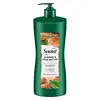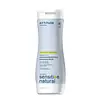What's inside
What's inside
 Key Ingredients
Key Ingredients

No key ingredients
 Benefits
Benefits

 Concerns
Concerns

 Ingredients Side-by-side
Ingredients Side-by-side

Water
Skin ConditioningSodium Laureth Sulfate
CleansingCocamidopropyl Betaine
CleansingSodium Chloride
MaskingPrunus Amygdalus Dulcis Oil
Skin ConditioningButyrospermum Parkii Butter
Skin ConditioningAloe Barbadensis Leaf Juice
Skin ConditioningCymbopogon Schoenanthus Oil
MaskingRosmarinus Officinalis Leaf Oil
MaskingChamomilla Vulgaris Extract
Skin ProtectingLavandula Angustifolia Flower Extract
CleansingSimmondsia Chinensis Seed Oil
EmollientDimethiconol
EmollientCarbomer
Emulsion StabilisingPPG-9
Skin ConditioningGuar Hydroxypropyltrimonium Chloride
Skin ConditioningTetrasodium EDTA
Amodimethicone
DMDM Hydantoin
PreservativeTea-Dodecylbenzenesulfonate
CleansingCitric Acid
BufferingC11-15 Pareth-7
EmulsifyingLaureth-9
EmulsifyingTrideceth-12
EmulsifyingMethylchloroisothiazolinone
PreservativeMethylisothiazolinone
PreservativeMica
Cosmetic ColorantTitanium Dioxide
Cosmetic ColorantCI 19140
Cosmetic ColorantCI 17200
Cosmetic ColorantParfum
MaskingWater, Sodium Laureth Sulfate, Cocamidopropyl Betaine, Sodium Chloride, Prunus Amygdalus Dulcis Oil, Butyrospermum Parkii Butter, Aloe Barbadensis Leaf Juice, Cymbopogon Schoenanthus Oil, Rosmarinus Officinalis Leaf Oil, Chamomilla Vulgaris Extract, Lavandula Angustifolia Flower Extract, Simmondsia Chinensis Seed Oil, Dimethiconol, Carbomer, PPG-9, Guar Hydroxypropyltrimonium Chloride, Tetrasodium EDTA, Amodimethicone, DMDM Hydantoin, Tea-Dodecylbenzenesulfonate, Citric Acid, C11-15 Pareth-7, Laureth-9, Trideceth-12, Methylchloroisothiazolinone, Methylisothiazolinone, Mica, Titanium Dioxide, CI 19140, CI 17200, Parfum
Water
Skin ConditioningSodium Coco-Sulfate
CleansingCoco-Glucoside
CleansingGlycerin
HumectantSodium Cocoyl Isethionate
CleansingLauryl Hydroxysultaine
CleansingCitric Acid
BufferingSodium Chloride
MaskingInulin
Skin ConditioningGlyceryl Oleate
EmollientSodium Benzoate
MaskingPotassium Sorbate
PreservativePanthenol
Skin ConditioningVitis Vinifera Seed Oil
EmollientGuar Hydroxypropyltrimonium Chloride
Skin ConditioningAvena Sativa Kernel Extract
AbrasiveHydrolyzed Soy Protein
HumectantWater, Sodium Coco-Sulfate, Coco-Glucoside, Glycerin, Sodium Cocoyl Isethionate, Lauryl Hydroxysultaine, Citric Acid, Sodium Chloride, Inulin, Glyceryl Oleate, Sodium Benzoate, Potassium Sorbate, Panthenol, Vitis Vinifera Seed Oil, Guar Hydroxypropyltrimonium Chloride, Avena Sativa Kernel Extract, Hydrolyzed Soy Protein
Ingredients Explained
These ingredients are found in both products.
Ingredients higher up in an ingredient list are typically present in a larger amount.
Citric Acid is an alpha hydroxy acid (AHA) naturally found in citrus fruits like oranges, lemons, and limes.
Like other AHAs, citric acid can exfoliate skin by breaking down the bonds that hold dead skin cells together. This helps reveal smoother and brighter skin underneath.
However, this exfoliating effect only happens at high concentrations (20%) which can be hard to find in cosmetic products.
Due to this, citric acid is usually included in small amounts as a pH adjuster. This helps keep products slightly more acidic and compatible with skin's natural pH.
In skincare formulas, citric acid can:
While it can provide some skin benefits, research shows lactic acid and glycolic acid are generally more effective and less irritating exfoliants.
Most citric acid used in skincare today is made by fermenting sugars (usually from molasses). This synthetic version is identical to the natural citrus form but easier to stabilize and use in formulations.
Read more about some other popular AHA's here:
Learn more about Citric AcidThis ingredient is derived from guar gum.
It is a conditioning ingredient, meaning it helps soften skin and hair.
Chances are, you eat sodium chloride every day. Sodium Chloride is also known as table salt.
This ingredient has many purposes in skincare: thickener, emulsifier, and exfoliator.
You'll most likely find this ingredient in cleansers where it is used to create a gel-like texture. As an emulsifier, it also prevents ingredients from separating.
There is much debate on whether this ingredient is comedogenic. The short answer - comedogenic ratings don't tell the whole story. Learn more about comegodenic ratings here.
The concensus about this ingredient causing acne seems to be divided. Research is needed to understand if this ingredient does cause acne.
Scrubs may use salt as the primary exfoliating ingredient.
Learn more about Sodium ChlorideWater. It's the most common cosmetic ingredient of all. You'll usually see it at the top of ingredient lists, meaning that it makes up the largest part of the product.
So why is it so popular? Water most often acts as a solvent - this means that it helps dissolve other ingredients into the formulation.
You'll also recognize water as that liquid we all need to stay alive. If you see this, drink a glass of water. Stay hydrated!
Learn more about Water